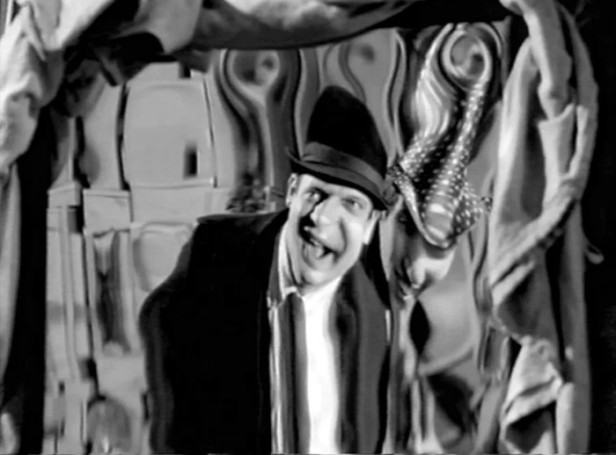In its original 59 minute version, Gerry Levy’s Where Has Poor Mickey Gone..? is far too long to sustain what is after all a single macabre joke. For many years, a version was circulating cut to 37 minutes or thereabouts which helped a little (it takes a lot less time to get to the punchline) but which robs us of some lovely London location photography and which surely no-one but the most impatient would be happy with.
Levy’s screenplay (written under the pseudonym Peter Marcus) has an EC Comics feel to it, a nasty little vignette with a not entirely to be taken seriously punchline. The full-length version opens with a to-camera performance by Northern Irish blues singer Ottilie Patterson (who belts out to the title ditty with other blues legends Chris Barber, Eddie Smith, Graham Burbridge and Sonny Boy Williamson on the soundtrack but not on screen). In the audience are a trio of rowdy youths out for kicks – leader Mick (John Malcolm) and his flunkies Ginge (Ray Armstrong) and Tim (John Challis, later much beloved as dodgy second hand car dealer in British sitcom Only Fools and Horses (1981-2003)) – who are unceremoniously thrown out along with posh boy Kip (Christopher Robbie), who persuades them to let him tag along for the rest of the evening’s mischief. Their rampage leads them to the unassuming workshop of a stage magician Emilio (Warren Mitchell, overdoing the mock Italian accent a tad) who they torment with threats of physical violence and by damaging his beloved props and contraptions (seven years later Stanley Kubrick’s Droogs would steal some of their modus operandi in the film version of A Clockwork Orange (1971)). But Emilio has, if you’ll forgive me, a trick up his sleeve – a cabinet that makes anyone placed inside it disappear… for good.

The whole think builds up to the “gag” about making members of the gang vanish and there’s an awful lot to get to before it finally makes good on the promise of its title. The early stages are the bits that mostly got cut from the bowdlerized version but they feature some of that terrific early-mid London location footage mentioned earlier (locations spotters will have fun recognising bits of Soho that look rather different today) but it does strand us with the not very convincing louts after they’re evicted from Club Indigo. They’re too late to be teddy boys, to early to be hippies and one suspects that Levy wanted us to take them for mods but no-one’s fooled. They’re just slightly-too-old for their roles actors playing the kind of generic, thrill-seeking thugs that British tabloids have long been overly concerned about. They do it well enough, but we tire of their shenanigans long before they find their way to Emilio’s.
It’s a very slight story that needs a good bit of padding to bring it up to that hard-to-sell length that’s not quite a short film but too long to be a feature. It did the rounds of British cinemas in 1964 propping up Euro import Lycanthropus (1961) – better known as Werewolf in a Girl’s Dormitory but released here as I Married a Werewolf – before going on to support The Black Torment (1964), The Night Caller (1965) (which also featured Mitchell) and a re-release of The Incredible Shrinking Man (1957) among others. Having been whittled down to 37 minutes it then disappeared into a sort of obscurity, at least in its full-length version and as such acquired a reputation that it doesn’t really deserve. It’s certainly passable as a time capsule of a post-Beatles, pre-swinging London and has a knockout final image hinting at the nasty fate suffered by those dispatched in the magic cabinet, but it’s not quite as good as it should have been really. There’s an awful lot to get through before we get to the meat of the story.

One suspects that screenwriter Sandra K. Bailey was a fan of the film as her script for the obscure 1987 Norwegian feature Turnaround, directed by Ola Solum, has a remarkably similar plot. The titles of Solum’s film credit David McGillivray, Dennis Lanning and Ray Selfe as providing additional material but there’s no credit for Levy who certainly got there first. Nor is he credited on Juan Piquer Simón’s La mansión de los Cthulhu/Cthulhu Mansion (1992) which also features criminal ne’er-do-wells gate-crashing the home of a magician with disastrous results. Levy went on to production manage Octopussy (1983), Out of Africa (1985) and Howling V: The Rebirth (1989) among others but only directed one subsequent film, the underwhelming Tigon science fiction thriller The Body Stealers (1969) in which more people mysteriously disappear without trace. For all its faults, Where Has Poor Mickey Gone..? is a lot more interesting.
As you say, better suited to an episode of The Twilight Zone with performances being a bit exaggerated. But it’s a typical little “twist at the end” film that’s entertainingly effective.
LikeLiked by 1 person